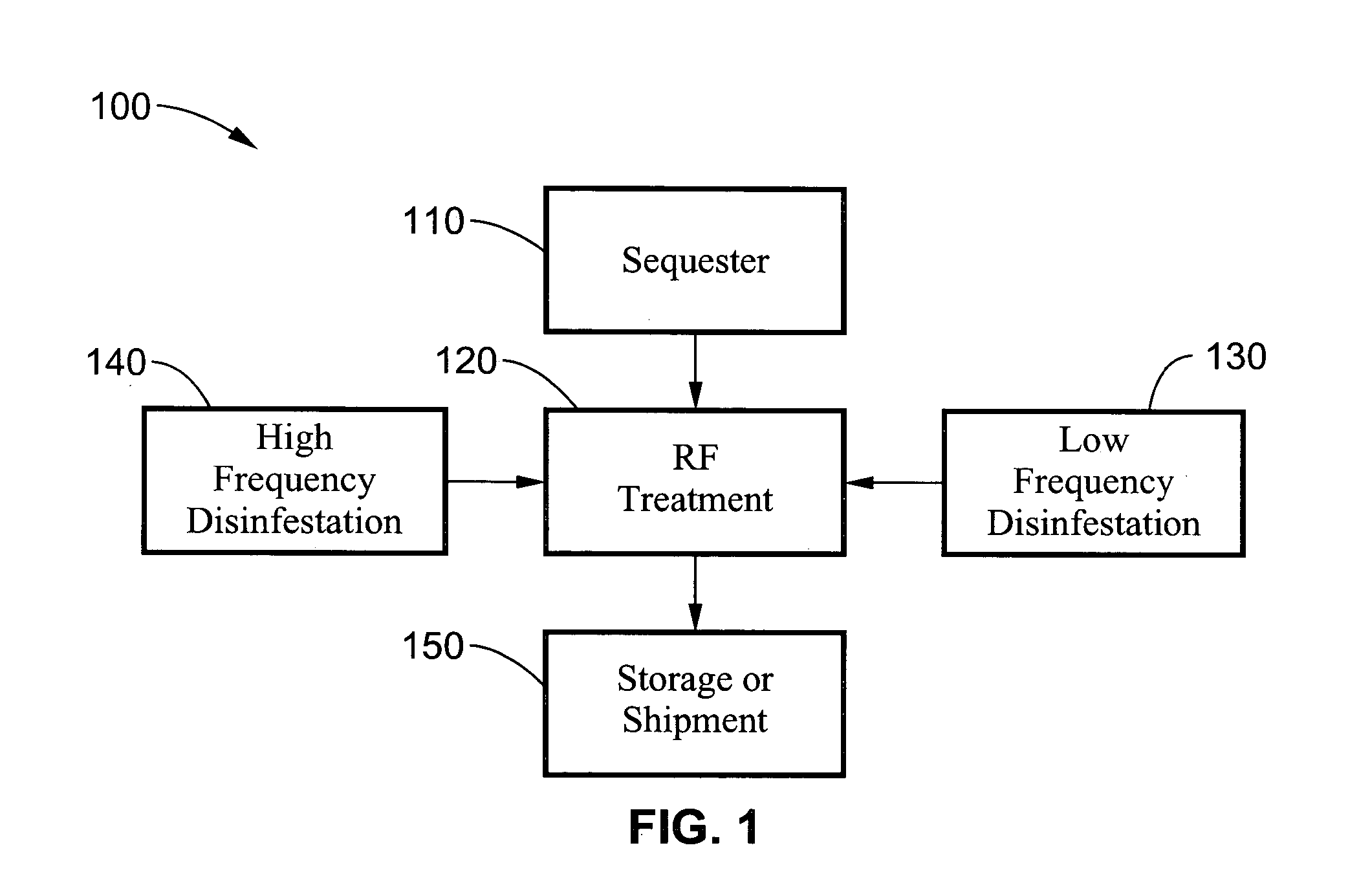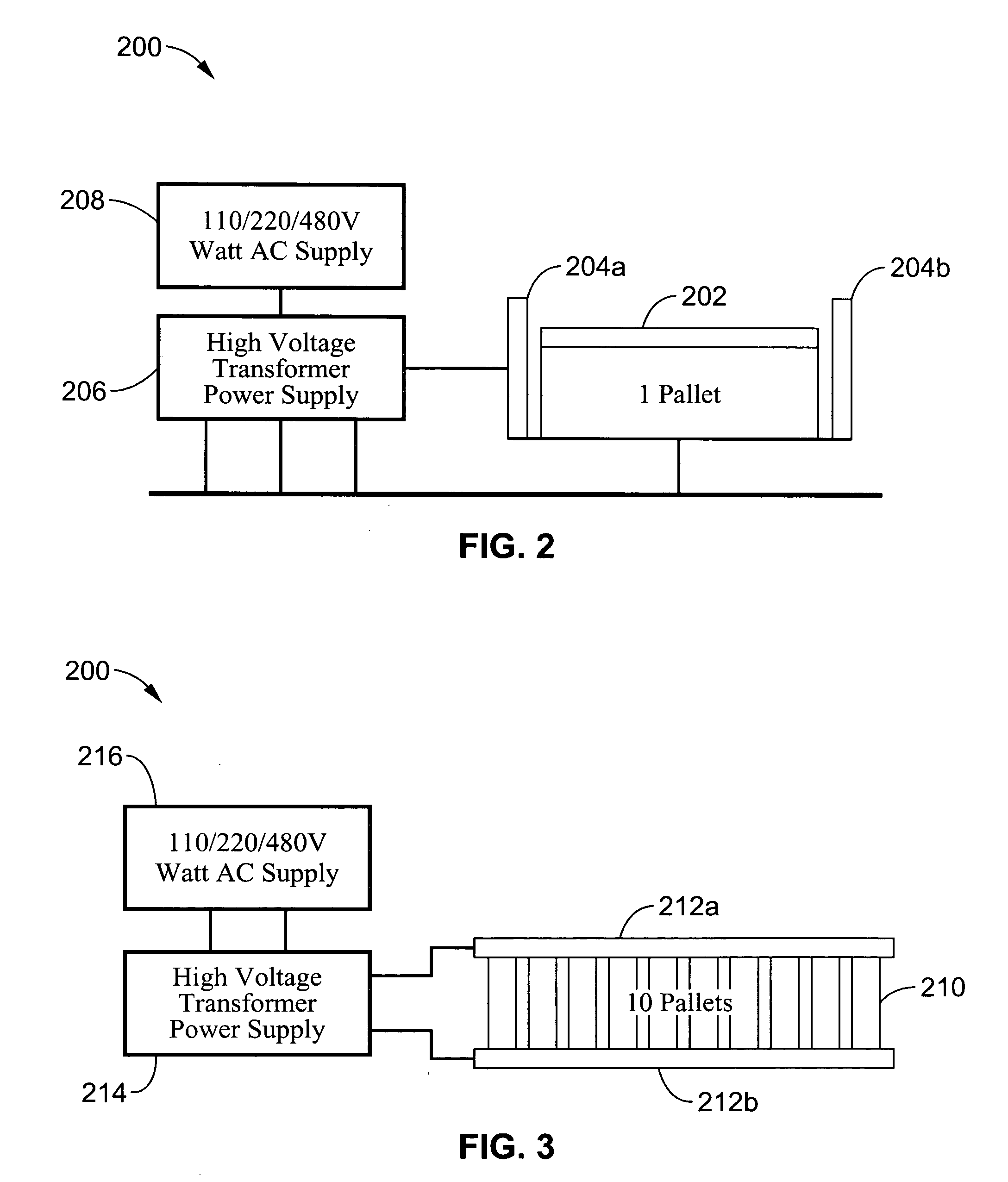Non-thermal disinfestation of biological pests with pulsed radio frequency power systems
a technology of radio frequency power system and non-thermal disinfestation, which is applied in the direction of disinfection, insect catchers and killers, construction, etc., can solve the problems of reducing the longevity of perishable commodities in the marketplace, increasing losses, and increasing the possibility of cross-infestation of commodities, so as to maximize the peak power of rf, short decay time, and rapid rise time
- Summary
- Abstract
- Description
- Claims
- Application Information
AI Technical Summary
Benefits of technology
Problems solved by technology
Method used
Image
Examples
example 1
[0102] The cumulative results of the low frequency RF disinfestation treatments at various field strengths and frequencies are shown in Table 1. Low frequency RF was arbitrarily defined as a using frequencies ranging from approximately 10 Hz to 1 MHz with a preferred field intensity of greater than approximately 5 kV / cm.
[0103] It can be seen that fruit flies and ants are particularly vulnerable to treatments with a field strength of 12 kV / cm and frequency of 60 Hz. Mortality of Thrip adults and pupas was highest when the frequency was within the range of approximately 300 to 350 kHz with a field intensity of between 23 kV / cm and 35 kV / cm.
example 2
[0104] Table 2 provides the cumulative results of the high frequency RF treatments for fruit flies on table grapes, almonds, blackberries and blueberries at a range of field strengths and radio frequencies. It can be seen that the frequency and field strength can be manipulated to identify the optimum fields and frequencies for a particular pest. Likewise, field strengths and frequencies can be selected to control multiple pests in single host commodity.
[0105] It can also be seen that both Low-RFD and High-RFD processes for fresh fruits and vegetables, works faster with oscillating field frequencies of less than approximately 150 MHz. For large volume treatments (batches) with Low-RFD, the process works better with frequencies less than approximately 0.1 MHz. For the on-line treatment with the High-RFD process, it reaches highest efficiency within the frequency range of approximately 5 MHz to 60 MHz.
example 3
[0106] In the treatment of liquids such as fruit juices, RF power can be applied directly to the commodity through inert conductive plates made of material such as Stainless Steel. Even though a commodity such as apple juice has a conductivity of 2.19 mS / cm, the major portion of the heat generated is due to dielectric effects at RF frequencies, rather than resistive effects. There is also no observed electrolysis of the liquid at RF frequencies. Measurements made of a test cell consisting of two Stainless Steel plates 5 cm×3.5 cm separated by 2 cm of apple juice show a capacitance of 80 ufd and an ESR (equivalent series resistance) of 75 Ω. The measurements were made with a Sencore LC103 ReZolver, 3200 Sencore Drive, Sioux Falls, SD. Based on the conductivity, the cell has a DC resistance of 570 Ω. Even with stainless steel plates in direct contact with the apple juice, The AC impedance is still much lower than the DC resistance. This effect lends itself well to RF treatments includ...
PUM
| Property | Measurement | Unit |
|---|---|---|
| frequency | aaaaa | aaaaa |
| frequency | aaaaa | aaaaa |
| frequency | aaaaa | aaaaa |
Abstract
Description
Claims
Application Information
 Login to View More
Login to View More - R&D
- Intellectual Property
- Life Sciences
- Materials
- Tech Scout
- Unparalleled Data Quality
- Higher Quality Content
- 60% Fewer Hallucinations
Browse by: Latest US Patents, China's latest patents, Technical Efficacy Thesaurus, Application Domain, Technology Topic, Popular Technical Reports.
© 2025 PatSnap. All rights reserved.Legal|Privacy policy|Modern Slavery Act Transparency Statement|Sitemap|About US| Contact US: help@patsnap.com



